Art World
Searching for Meaning (aka Art Trends) at the 2017 Armory Show
Some topical fare, and some not-so-topical fare, at this year's big show.
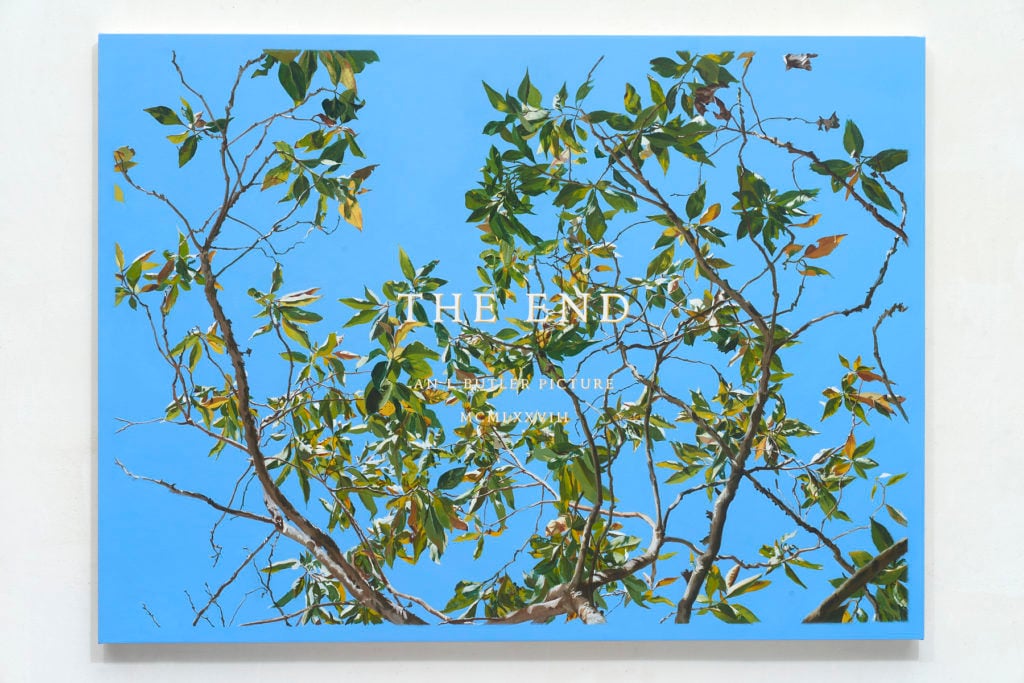
Some topical fare, and some not-so-topical fare, at this year's big show.

I went to the Armory Show 2017 determined to spot trends. That’s an honorable way to use this kind of experience, I feel: as a gauge of what the appetites of the art market are—or at least what some hopeful vendors think they are.
What I forgot was that looking for trends at an art fair is like looking for patterns in a handful of M&Ms. Maybe the patterns are there, but if they are, it’s a little extraordinary—and probably because someone has been tampering with the package, or snapping up all the blue ones, or something. It’s suspicious.
Still, trends do pop up from time to time at art fairs, coalescing as if by magic out of the intertwining aspirations of the organizers and the exhibitors, as they grasp at the moment. Sometimes it’s a surge in works from particular countries, like China and then Brazil a few years ago. Sometimes it’s a particular artist who ascends, suddenly, to prominence (the foil paintings of Anselm Reyle were big in the pre-crash days). Sometimes it’s a certain type of media, like when arty ceramics were suddenly, briefly, a thing.
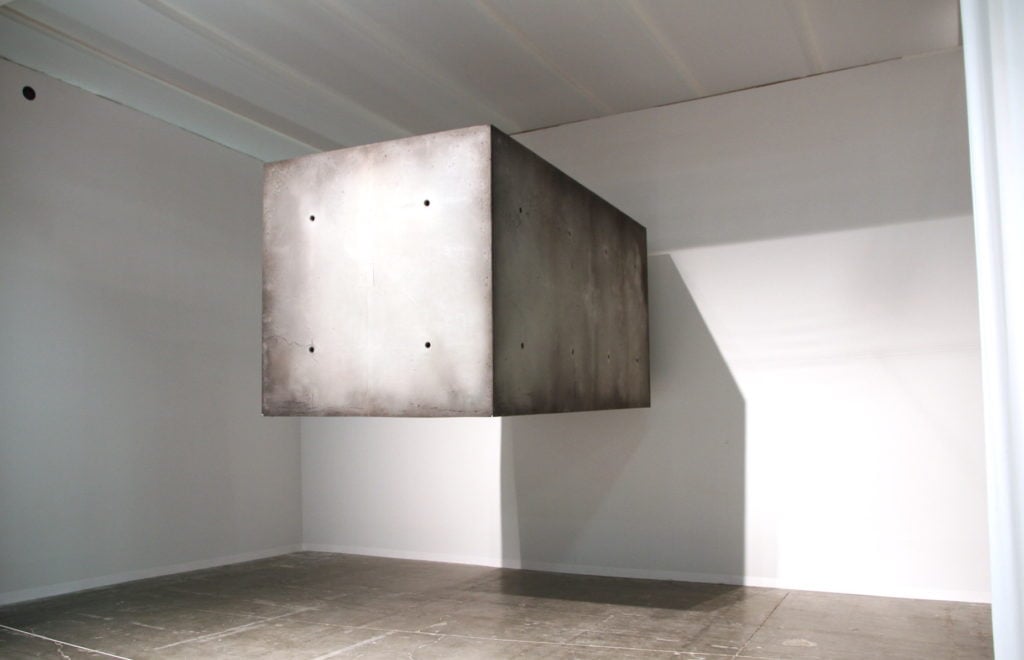
Drifter (2017) by Studio Drift. Courtesy Henri Neuendorf
But after hours of circling the contemporary section on Pier 94, this year’s Armory Show does not seem to have a lot that marked this year out for me, specifically. There were individually memorable spectacles, like Studio Drift’s giant, magically floating concrete cube (it’s actually a cleverly disguised balloon, I gather), a work which could illustrate the dictionary entry for Big Fun Art.
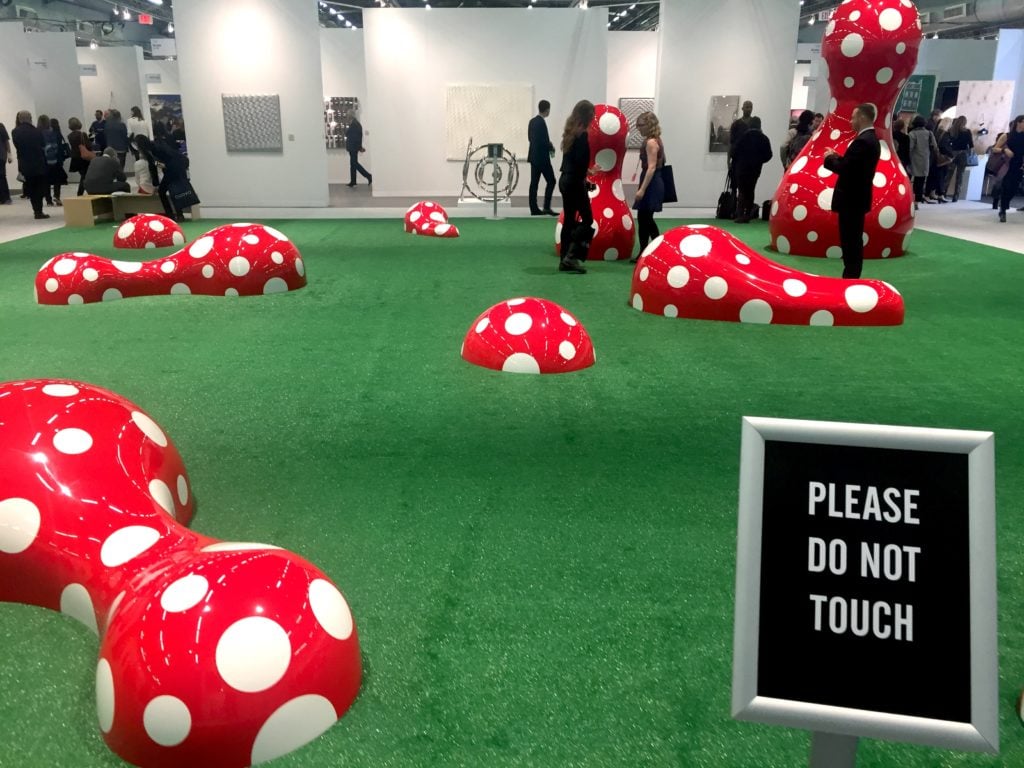
Yayoi Kusama’s Guidepost to the New World (2016) at the Armory Show 2017.
In the same Big Fun vein, there’s Yayoi Kusama’s Guidepost to the New World (2016), a grove of groovy, polka-dotted glob sculptures plopped in the center of the action courtesy of curator Eric Shiner’s special program of sculptures for the fair.
Design-artist Sebastian Errazuriz, known for sculptural one-liners, suspends an upright piano over the fair’s Champagne Lounge, introducing a note of photo-ready cartoon menace. (UPDATE: In an email, the artist points out that the full context of the work, The Awareness of Uncertainty, is that it is “a reenactment of the actual piece that the artist lived under between 2008 and 2013 in his first New York studio,” as a tool to focus his creative energies.)
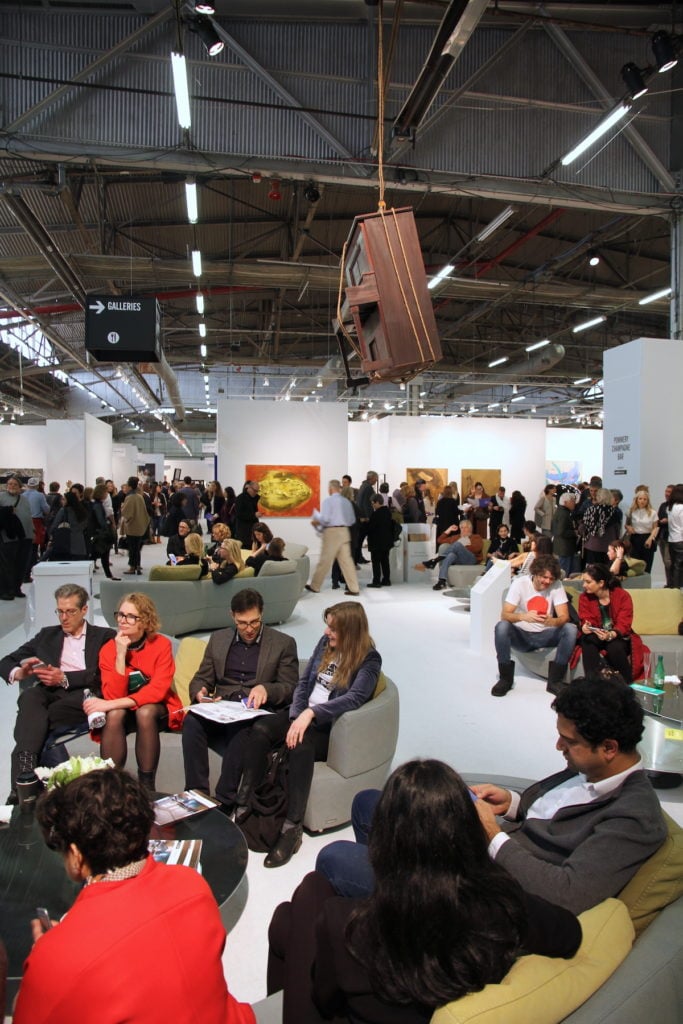
Sebastian Errazuriz’s piano suspended over the Champaign Lounge at the Armory Show 2017.
But does the fair announce 2017 as the Year of Big Fun Art? Not really. That’s just art-fair style in general.
There are artists you see a lot of here. At least four galleries, for instance, were showing photo works by Marina Abramović. But similarly, that’s not really a new trend. Abramović is everywhere. There’s nothing new in that news.
You’d expect this fair, the first big one of 2017, to feel a little different, if only because we live in a grim fever dream of a time, politically and culturally. A lot of big, big paintings grace the walls of this maze—but if you were expecting big statements about, for example, the defense of the National Endowment for the Arts at this art-industry gathering, you will be disappointed.
Still, Armory Show 2017 is a more topical fair that it looks at first brush, and that topicality stands in for a trend, giving at least a sense of the present.
At Jack Shainman, Carrie Mae Weems has a work from last year’s “All the Boys” series, presenting a silkscreened photo diptych, one half a smudgy portrait of a figure with its face blocked out with a red rectangle, the other a blown-up booking form for Sandra Bland, the 28-year-old African American woman who mysteriously hung herself in jail in 2015 after an unjust traffic stop, becoming yet another symbol of the grim stakes of belligerent “law-and-order” rhetoric.
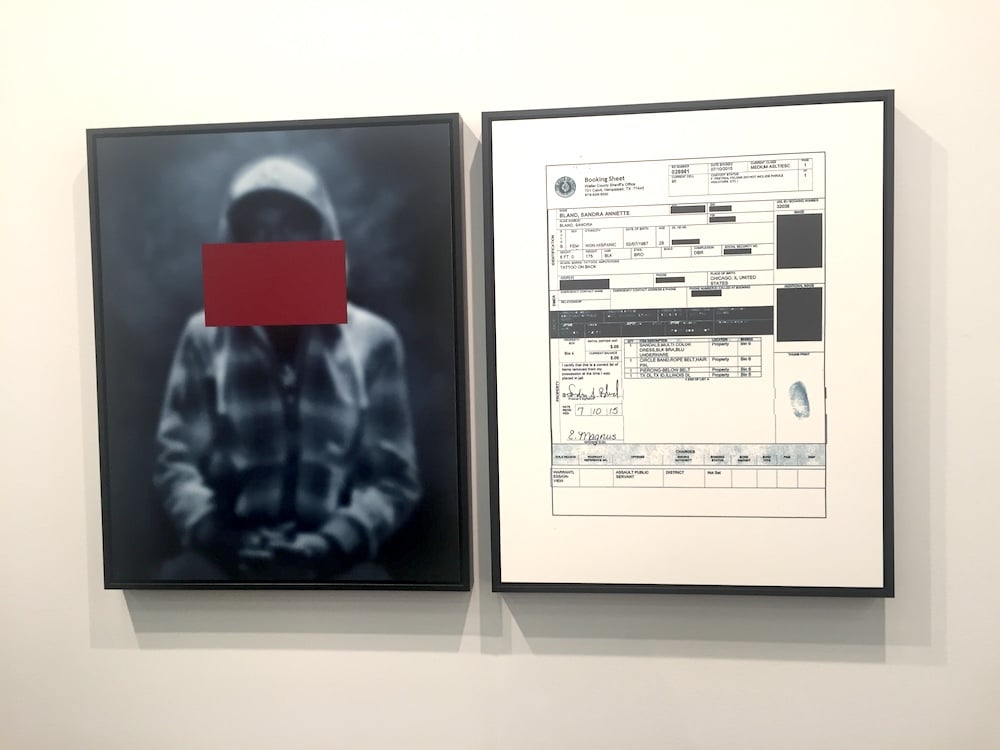
Carrie Mae Weems, All the Boys (Blocked 1) (2016) at Jack Shainman.
At Thaddaeus Ropac’s booth, Robert Longo gives us Study of Elegiac Flag #2 and Study of Helena, in his signature intense and moody charcoal. The former is exactly what the title suggests, the latter focuses on a woman’s eyes staring levelly out from a niqab. These are both 2016, and particularly in their pairing, can’t help but reflect the nasty debates about who gets to count as an American.
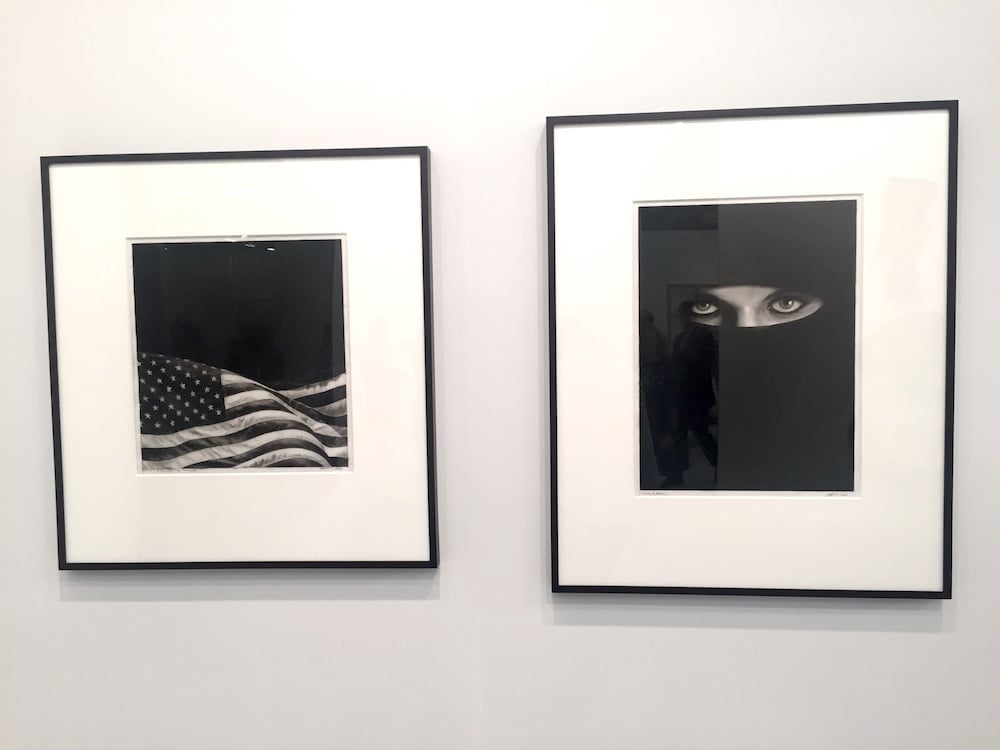
Robert Longo, Study of Elegiac Flag Series #2 and Study of Helena (2016) at Thaddaeus Ropac.
At Paris’s Mor Charpentier, Edgardo Aragón has a piece featuring a map of North America that is clearly oriented on the debate over the president’s border wall and rhetoric about Mexicans stealing resources from the US. Instead of the familiar border, there’s the suggestion of enforcing a wall along pre-Mexican-American War lines, when the U.S. seized land from its southern neighbor. Over the Eastern half of the United States, there’s an image of a serpent eating its own tail. (Based on the title, Absolut World, Aragón’s piece seems also to refer to a dust-up in 2008 when Absolut Vodka was forced to apologize after running an ad in Mexico with a map showing the original territory with the slogan “In an Absolut World.”)

Edgardo Aragón, Absolut World (America) (2017) at Mor Charpentier.
At Chicago’s Kavi Gupta, Glenn Kaino has an intense installation, mocking-up some kind of figure being burned, a pyre built of charred charcoal sticks inscribed with slogans like “Death to Fascism” and “Dying of Comfort,” while a trick of orange light and vapor coming from its base makes it all appear as if it is about to burst into flames any second—the symbol of a combustible moment.
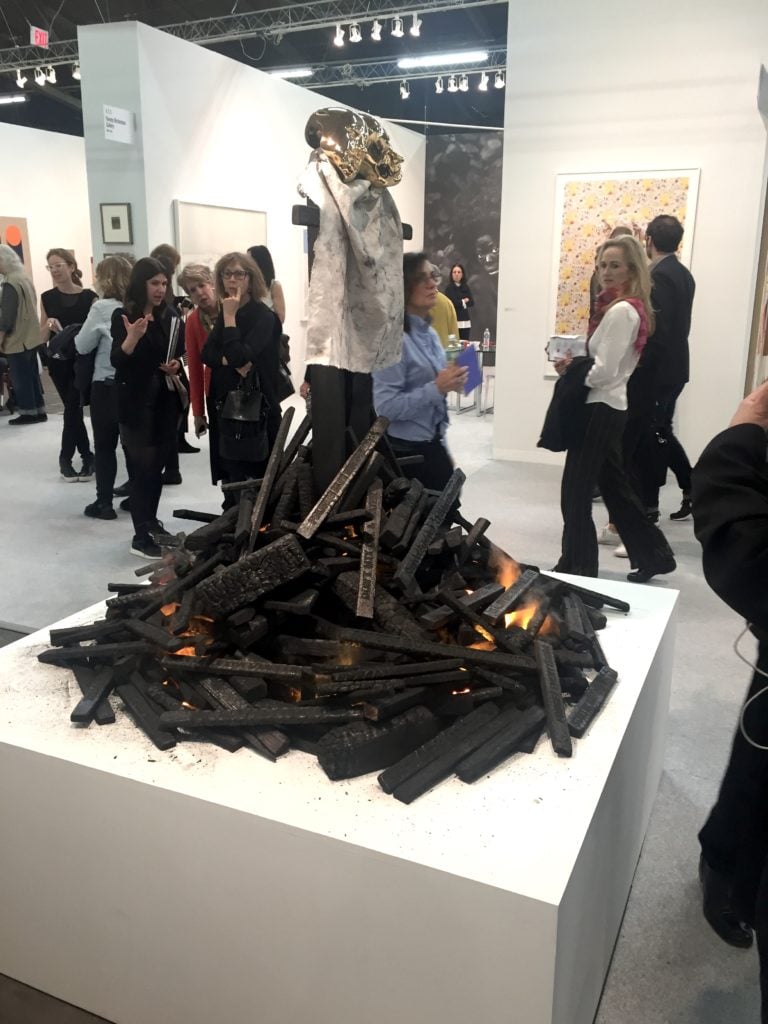
Glenn Kaino, In Girum Imus Nocte Et Consumimur Igni (2016) at Kavi Gupta.
At Ben Brown Fine Arts, the young artist Awol Erizku (in the news recently for styling an Instagram portrait of a pregnant Beyoncé, the most-liked picture in the app’s history) offers the image of the U.S. flag, with the lunging Black Panther symbol stitched over it. The blunt title for this blunt work is How That Make You Feel? (2017).
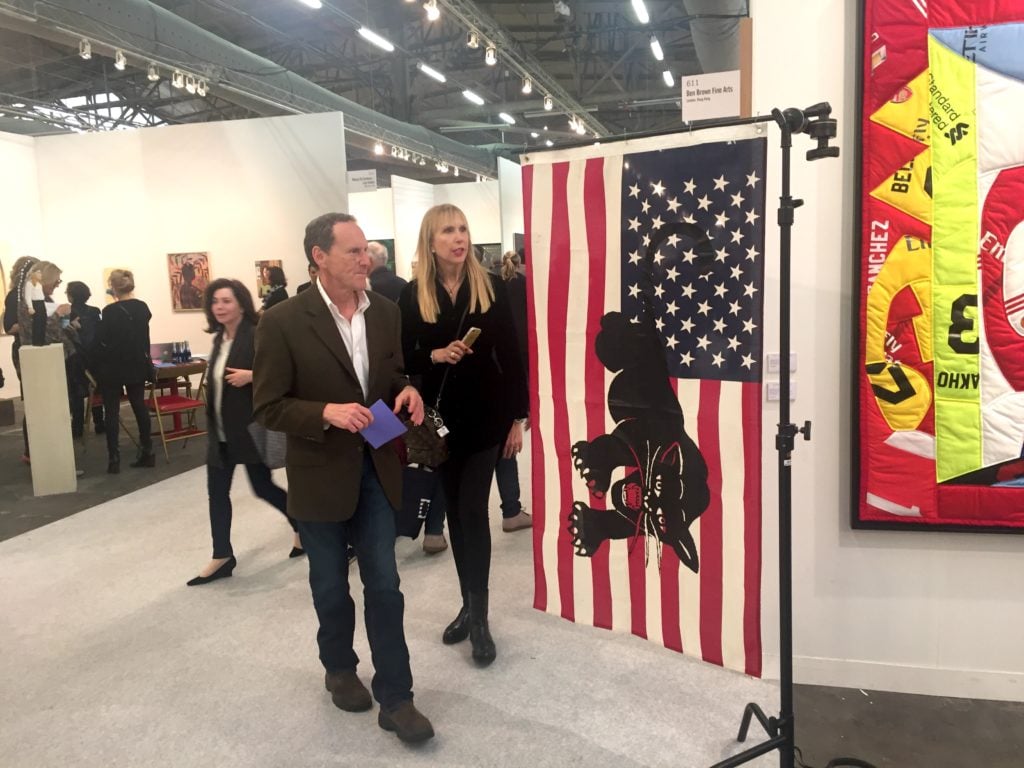
Awol Erizku, HOW THAT MAKE YOU FEEL? (2017) at Ben Brown Fine Arts.
At kaufmann repetto, L.A. artist Andrea Bowers, known for her homages to activist culture, gives us a blinking sign that declares the word “RESISTERS,” the “SISTERS” part marked off in purple lights.
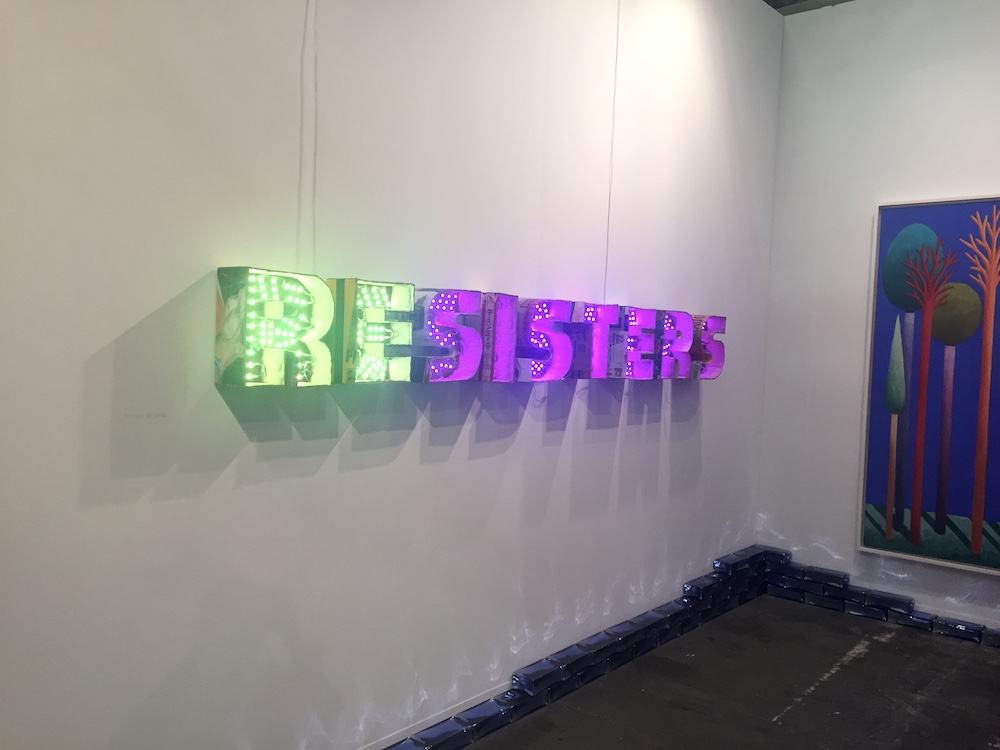
Andrea Bowers at kaufmann repetto.
Despite all these works—and there are many other such statements of varying degrees of strength, amounting to a kind of shiver down the spine of the party—the truth is that this year’s Armory Show still doesn’t read as either particularly dark or particularly uplifting.
But then, in the end, looking for political enlightenment at an art fair is like trying to use a jet engine as a flotation device. It’s just not what it’s for.
On my trend-spotting mission, I found plenty of usual art-fair stuff—big photos, blinking neon words, stylishly vague abstract paintings, etc. In the end, though, I fixated on the drumbeat of honest-to-god, contemporary nature paintings.
Some, like the recent works by Alex Katz at Peter Blum, are quite sincere in their small-scale lyricism, setting a self-consciously old school tone.
Whitney Bedford’s desert landscapes at Suzanne Vielmetter are more deliberately contemporary in design, vistas of spidery brush depicted against a flat, bright-red sky.
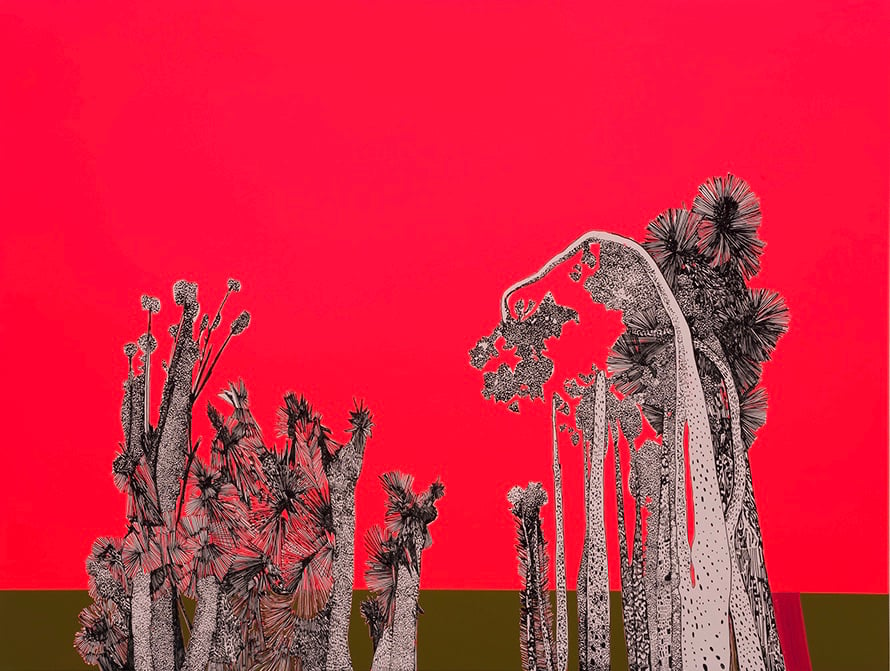
Whitney Bedford, Two Parties (2017). Image courtesy Suzanne Vielmetter.
At Kavi Gupta, Claire Sherman’s Ferns (2017) render a lush image of just that: leafy, lovable, soothing ferns.
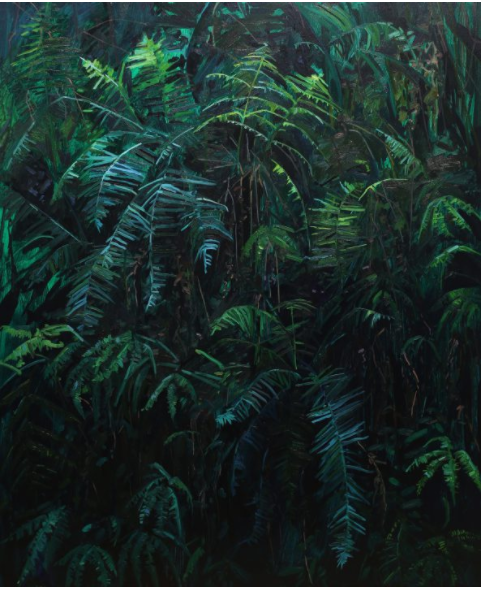
Claire Sherman, Ferns (2017). Image courtesy Kavi Gupta.
Satoshi Ohno’s groovy vegetable imagery at Tomio Koyama gallery are inspired, I gather, by the epiphanic relationship to nature in German Romanticism, despite their psychedelic vibe.
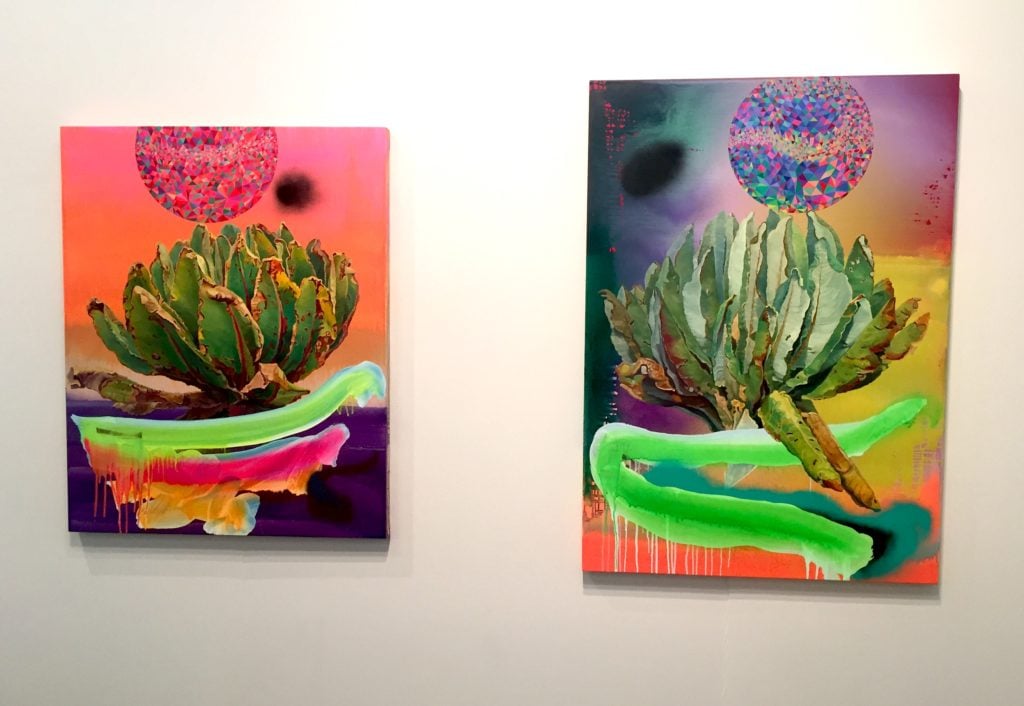
Satoshi Ohno at Tomio Koyama.
At Anat Egbi, Martin Bashir’s paintings of palm trees knowingly channel stereotyped tourist images, like something you’d see on the wall of a dentist’s office, nature saturated in media-soaked irony.
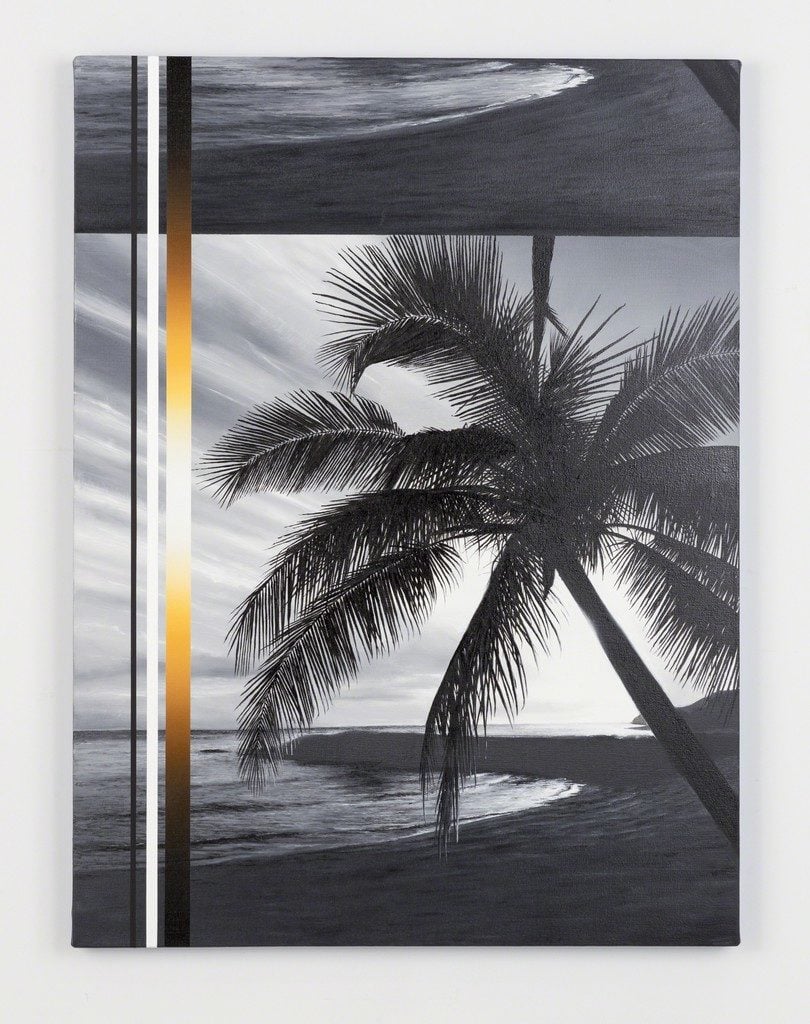
Martin Bashir, TB (2017). Image courtesy Anat Ebgi.
The flip side of this sensibility is at Nicelle Beauchene, where Ryan Nord Kitchen’s landscapes reference the fuzziness of embodied memory rather than the vividness of the media’s simulated imagery. His small landscapes are so deliberately abstracted that you might not even guess what they were, executed from memory instead of en plein air and telegraphing that fact.
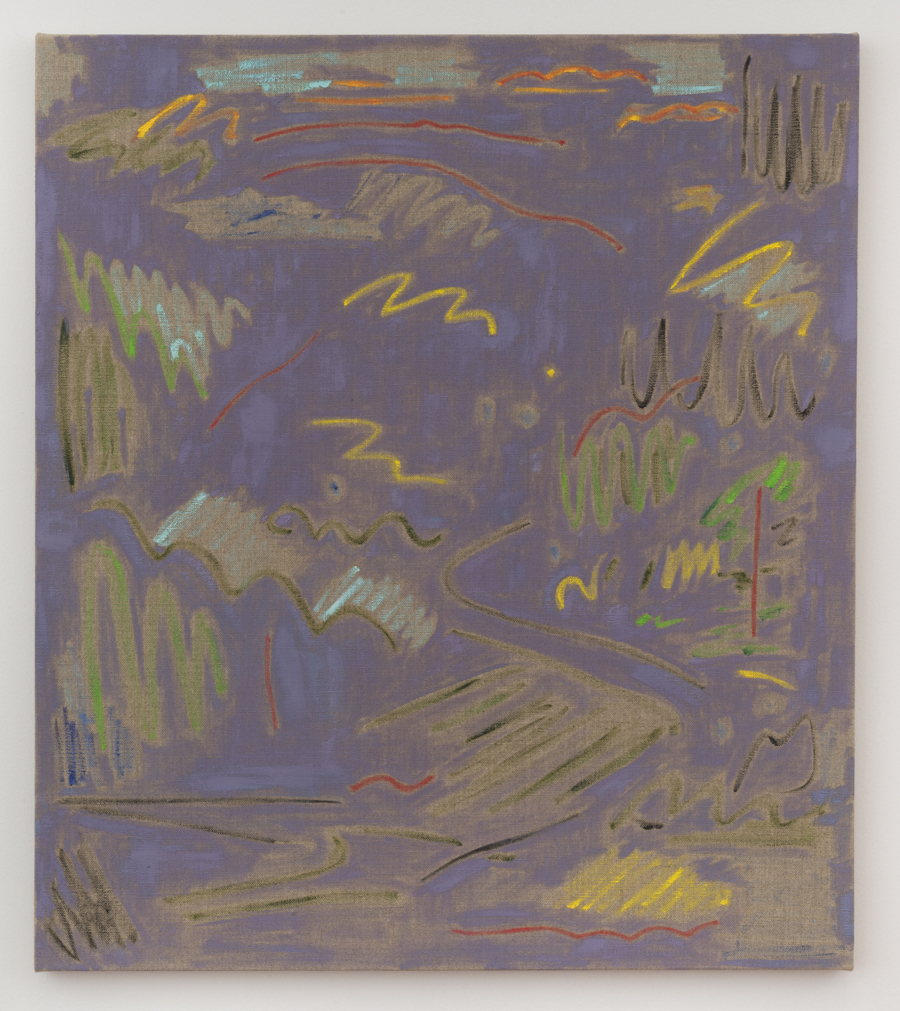
Ryan Nord Kitchen, Dusk (2017). Image courtesy Nicelle Beauchene.
Breaking into three dimensions at i8, Icelandic superstar Ragnar Kjartansson has a series of dioramas, presenting little desolate vistas with his characteristically evocative and deliberately heart-on-sleeve neo-Romanticism.
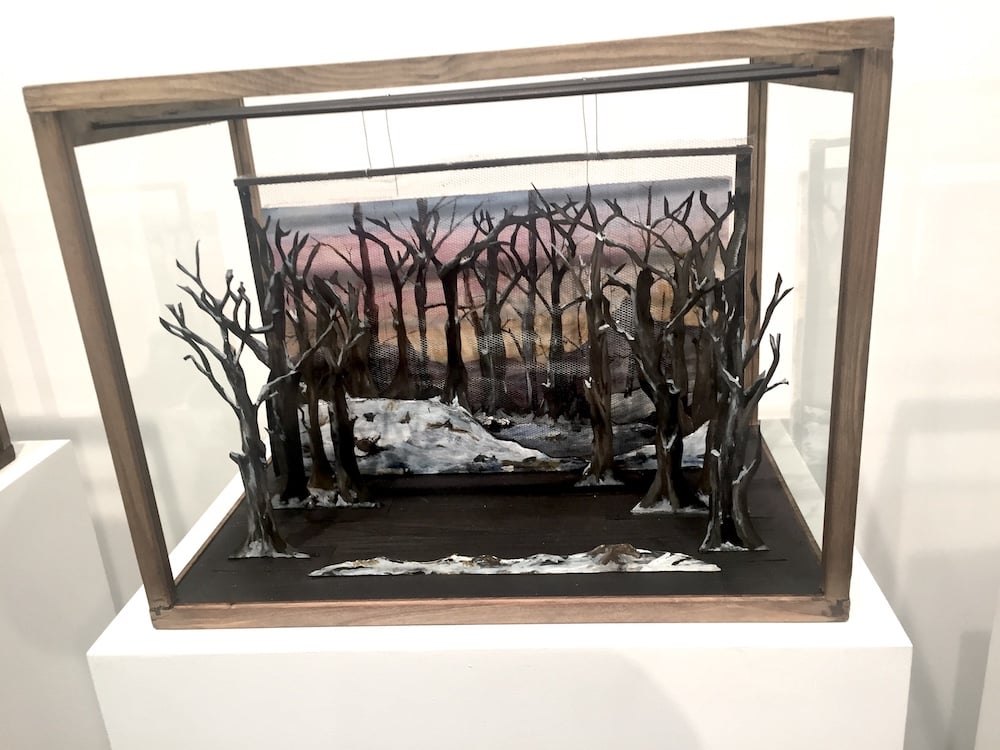
Ragnar Kjartansson, Klang der Offenbarung Dioramas (2016) at i8.
Again, I could go on in this vein, and I don’t really know if it says anything specifically about the present, since there are always landscapes, just as there are always political statement pieces.
There does seem to be an intensity about both, which makes some sense, as two sides activate each other: Landscape, paradoxically, has always represented the quintessential urban art, the space of picturesque contemplation that one retreats into as the angst of civilization intensifies.
That tension is what, I think, is suggested by the paintings of Luke Butler at Jessica Silverman. One of these canvasses presents a glimpse of the sky through trees, overlaid with the words “THE END”—evoking the final shot of a movie as the camera wanders away from the human drama and into the ether.